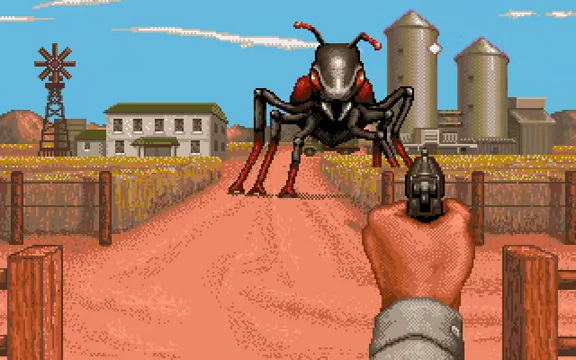
Last week, a trailer appeared online for the upcoming film IT CAME FROM THE DESERT, a new Finnish production from director Marko Mäkilaakso (WAR OF THE DEAD) and producer Teemu Virta. The film looks like a relatively standard, if entertaining, creature feature, as a motocross racer faces off against giant ants in the desert.
For some horror fans, this trailer most likely brought forth memories of THEM! or EIGHT-LEGGED FREAKS (or more recent homages to the giant creature flick, like BIG ASS SPIDER), but for old gamers like myself, the title and premise brought forth a hefty chunk of nostalgia. You wouldn’t know it from the trailer, but IT CAME FROM THE DESERT is based on a video game by the same name – the only clue that the brief snippet gives to its origins is at the very end, when the logo of Cinemaware, the original developers of the game, appears amidst a half-dozen other production companies. At first glance, IT CAME FROM THE DESERT is inspired by THEM!, but in fact, it’s inspired by a game that was, itself, inspired by THEM!, bringing the original concept of the tale of giant ants invading a small desert town back to its celluloid origins.
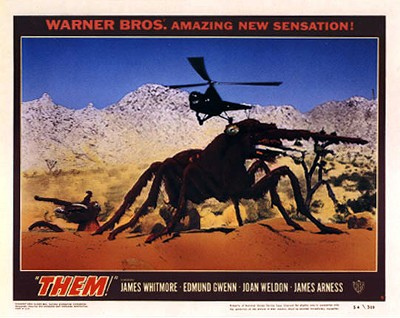
The thing is, if you’ll notice some of the comments leveled at the trailer on both the YouTube page and any other horror site that’s covered it, there’s some discrepancy as to its origins. Sure, it’s called IT CAME FROM THE DESERT, but outside of the location and the existence of giant ants, it seems to bear little resemblance to the tongue-in-cheek computer action/adventure game released in 1989 that became a sleeper hit on the Commodore Amiga. Or so it seems to some viewers – other viewers seem to think it’s a pretty loyal adaptation, with the lead character a young guy on wheels just as it was in the game they remember. It’s almost as though they’re remembering two entirely different games.
But It Came From the Desert isn’t two entirely different games.
It’s three.
Phase I – Amiga Ant Farm
Originally formed in 1985 by husband-and-wife duo Bob and Phyllis Jacob, Cinemaware was formed when movie buff Bob wanted to create games for the burgeoning home computer market based on popular movie genres. Their first title, 1986’s Defender of the Crown, was a huge hit when released to the Commodore 64, Amiga and Apple computers, with its blend of stand-of-the-art graphics and mini-games based on classic adventure films. Defender put them on the map, and the title was ported to a variety of other systems.
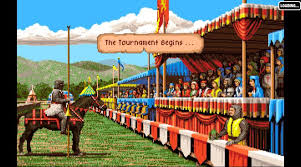
However, getting lightning to strike again was difficult. Subsequent titles failed to catch on, as eye-catching graphics couldn’t compensate for lame gameplay, resulting in a series of titles that were alluring on the page, but not actually fun to play. (One of the exceptions to this was the popular adaptation of The Three Stooges, which used the classic comedy team to good effect in a series of mini-games in order to save an orphanage.) They attempted to add depth to their titles with the sci-fi serial-inspired Rocket Ranger and the samurai epic Lords of the Rising Sun, but both titles failed to be genuinely enjoyable to vast gaming audiences.1
Enter David Riordan. A former songwriter, having written Sugarloaf’s classic rock standby “Green-Eyed Lady,” Riordan had moved into software development in 1980 and worked with Lucasarts on Ballblazer, their first entry into the video game field. He then worked for Atari as part of their Laserdisc arcade game development team, garnering an interest in combining film and video games.
Riordan was inspired by Defender of the Crown, and contacted the company. Bob Jacob soon offered him a job, placing him in charge of the developer’s “Interactive Entertainment Group,” a department meant to create more sophisticated “interactive movies” beyond the Amiga platform.
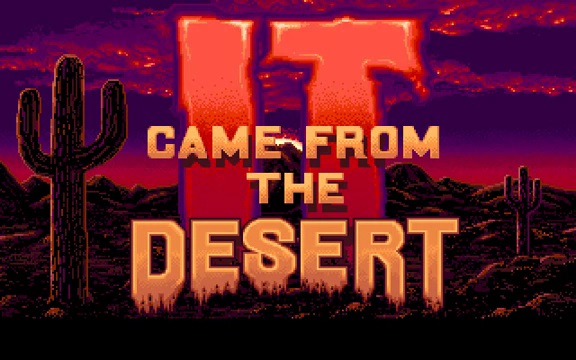
“In my fest meeting with Bob he asked me what interactive movie I wanted to make,” Riordan explained in an interview with RetroGamer in 2006.2 “I’d been thinking about creature films so I just said ‘big bugs.’ It was the one story he hadn’t thought of and he hired me as a result. Growing up I’d been fascinated by the pulp sci-fi creature films that began with the classic Fifties film THEM!. I loved the pulp fiction, the bad special effects and the beautiful screaming girls. When I began to think about what kind of stories would lend themselves to interactive narratives, big ants attacking a small town seemed like such a natural fit. It was fun and campy at the same time. You didn’t have to explain too much about what to do. You either stopped the ants or you got eaten.”
When structuring the game, Riordan sketched out the small desert down of Lizard Breath first before moving into the plot, an unusual move at the time when it came to video game world-building. “Because of my training in linear storytelling and television production I tackled Desert like a movie first and then defined what the gaming elements would be. I needed to ‘live’ in the story a bit before I could figure out what would make it a fun action-adventure game. I wrote an initial document that described the town, some of the characters and potential gaming situations. I had crude storyboards created to give a feel of what I was thinking about and then very early on I got screenwriter Ken Melville involved and we began fleshing out all the characters just like we were creating a story bible for a film. It was Ken who gave Lizard Breath and its inhabitants their dramatic flavor and pulp color.”

In addition, It Came From the Desert would use a method of time management that would cause a specific time limit on the game, rather than simply having the player run out of lives. “I knew I wanted to experiment with a ‘real time’ environment where, like real life, the player couldn’t be in all places at once. It made sense to me that the ‘impending’ doom of big bugs headed towards town was time sensitive. This added to the tension. If the player did nothing or goofed around, the town was overrun. They also needed to pay attention to the clues and outcomes of dramatic situations if they wanted to be in the right place at the right time to stop the ants. It seemed to Ken and I like a good way to make the story elements matter to the gameplay instead of just ending up as window dressing for the game sequences.”

Getting the tone right in replicating the mood of the ‘50s giant monster pics was a key point, and one critical to the success of the game. “Half the fun was trying to get the town’s people to listen to the hero when he warned them something strange was afoot. How many times have we seen a minor character in a big bug film scoff at the idea of danger, only to be eaten before he can finish his sentence? We loved the black humor of those moments. The player in Desert needed help to ultimately be successful and the level of help he would receive was completely based on what he discovered.”
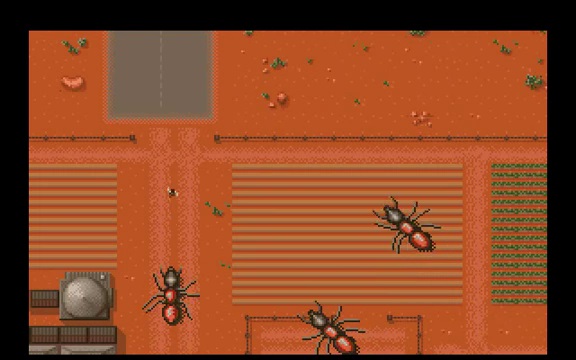
Like many Cinemaware titles, the game featured a number of mini-games – though again, the bar was raised as to their content. “All the mini-games were also dramatically based on story elements in the town of Lizard Breath. They included a Fifties knife fight with some punks, the classic Fifties game of chicken in hot rods, you could rent a biplane and scout for ants and there was a fire-fighting game when the ants got too frisky and tipped something over.”
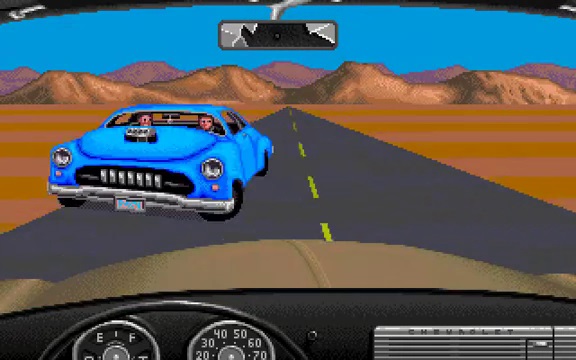
“One of people’s favorites was the hospital game. The player could choose to stay in bed for the allotted time or try to escape and not pay the time penalty. The hospital game was an afterthought when we realized that players loved to get mauled by the ants. It also gave us a chance to throw in the buxom nurse (the infamous Cinemaware cleavage as it was called) that was so typical of Fifties horror films!”
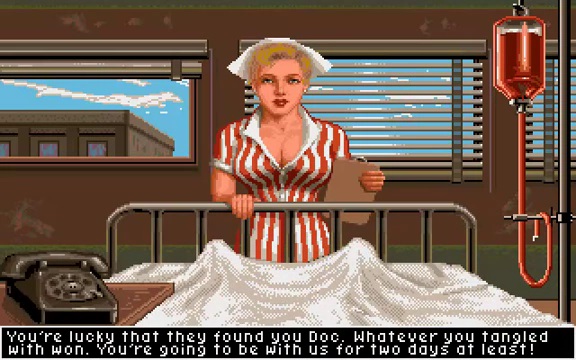
With Riordan and writer Melville at the helm, It Came from the Desert was released for the Commodore Amiga in the fall of 1989. “The desert, unchanged for millions of years,” proclaims the opening narration. “Yet witness to a biblical prophecy come true that one day, the meek shall inherit the earth.” The player then takes control of geologist Greg Bradley, who is working in the small town of Lizard Breath when he happens to notice strange things afoot. A meteor, it seems, is responsible for making the previously normal-sized ants of the area into giant, flesh-eating monsters, and it’s up to our hero to convince the town via wandering around and having conversations that there’s danger afoot while fending off fires, chicken drivers, ants, and quick-witted nurses. There are multiple endings, depending on how adept your hero is, but it’s virtually impossible to “die” in the game, meaning that nothing ever seems completely hopeless. Heck, you can go ahead and play it in your browser right now here. (You’ll want the Amiga version that can be played with an Amiga 500 emulator – the DOS version, released in 1991, lacks some of the control and graphical flourish.)
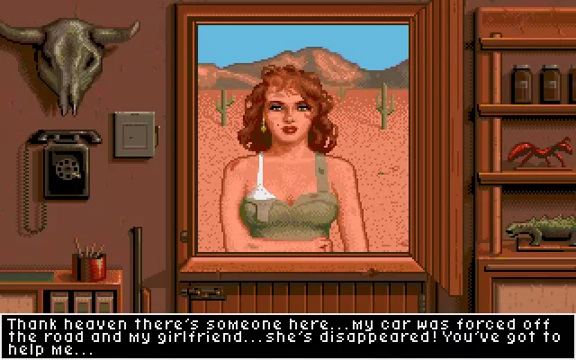
The game became a big success. It shined in relation to previous Cinemaware titles, with Computer Gaming World claiming that it’s not “just another pretty set of sounds and graphics. It Came From The Desert is a very playable and compelling game with many enjoyable hours to be experienced.”3. CU Amiga-64 gave it 96%, calling it “Cinemaware’s most complete game yet.” 4 The only major complaints had to do with the game being on three disks, with Amiga Format reducing it to 80% due to the disk swapping necessary to play.5 It was even successful enough to appear as an in-joke in other games, such as a box for “It Came From the Dessert” in 1991’s Space Quest 4.
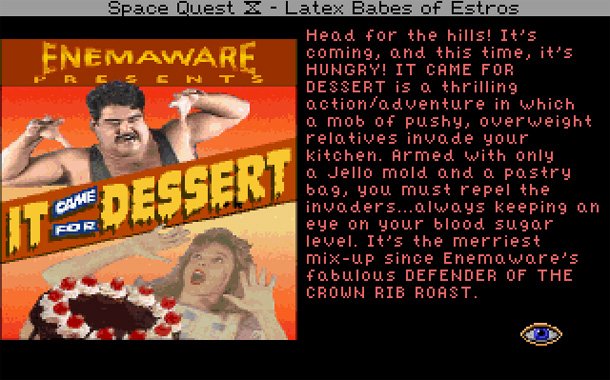
With It Came From the Desert a hit on the Amiga, it was only natural that other formats would want in on the action as well.
Phase II – Empire of the Ants
In 1990, Cinemaware wanted to expand the reach of It Came From the Desert. They’d released an expansion disk called AntHeads (sometimes referred to as It Came From the Desert II) to the Amiga that added a few new puzzles and scenarios, but otherwise didn’t change the format. The next step was console gaming, which had been making a comeback after the crash of the early ‘80s.
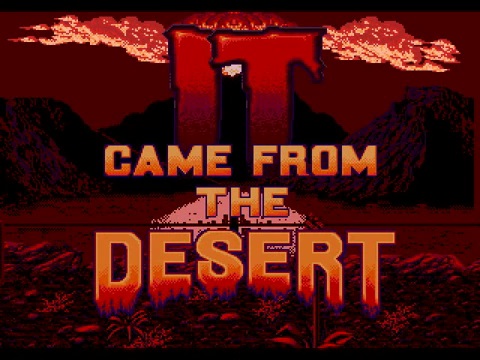
The plan was to translate It Came From the Desert to the Sega Genesis/MegaDrive, and the task was commissioned out to developers at New World Computing. However, the intricate adventure nature of the original game was thrown out entirely, and a character not even present in the Amiga version, Buzz, became the central role in a relatively straightforward overhead-view shooting game. The locale was changed to “Lovelock” rather than the more awesome-sounding Lizard Breath, and the plot had something to do with the ants creating volcanos.
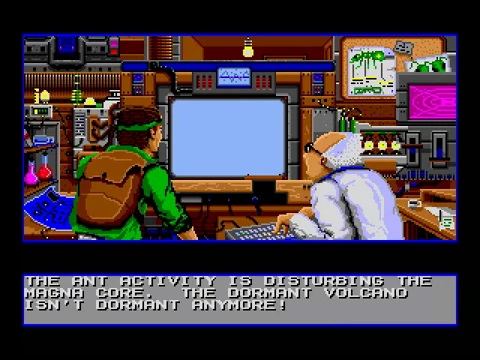
Matt Harmon was the lead programmer and designer on the project. “The Sega Genesis version of It became an arcade style game because it did not appear practical to create a standard Cinemaware type title on a platform that clearly worked best running 2D side scrolling type games (i.e. Sonic The Hedgehog) due to the memory limit on the cartridges, and the animation was sprite based (bit copies not practical and tiling the norm). We kept the concepts of the original prototype but revamped all the graphics and code.”6
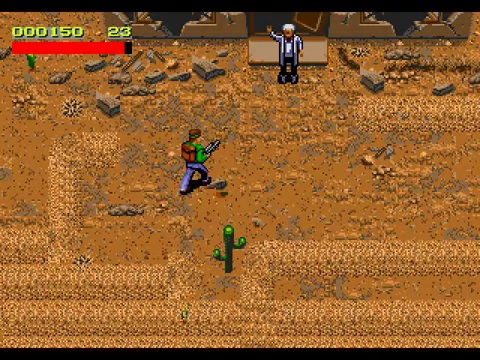
The project had already started when Harmon arrived. “New World [Computing] showed me, on a Sega Genesis development system, an already running first level of It Came From The Desert converted to a top-down style game. It was a character with a green shirt, blue jeans, and flame thrower and there were dirt snakes (i.e. ants). That was it, no collision, no levels, no audio, etc, etc. The controls were very slow, and the object sizes did not allow for full gameplay. Clearly the original developer had left, and they needed a replacement for this game to be published by Electronic Arts. So of course, at $12.00 an hour, I took the job. They assigned me an awesome artist – we were the full team. I immediately ran out and bought my first car.”
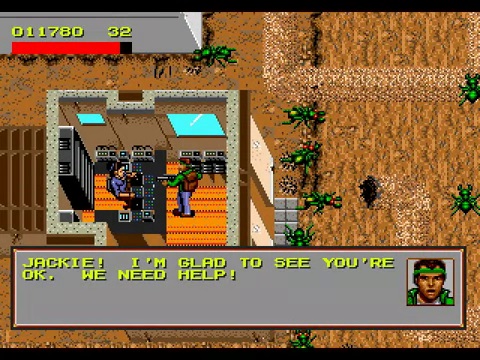
Unfortunately for Harmon, the title was never released due to Electronic Arts halting distribution on any non-sports titles. “I hate this part of the story. It’s my very first game, 99.99% finished, and it does not ship. First off, there was one more hand in the pie, near the end, Electronic Arts provided an audio engineer. He provided the music/sound driver and the actual music and sound effects. So, clearly EA was into the game. I remember I liked the music, and I remember there was work on my end to make all the sound effects work right. It was only 99.99% finished, to me, because there was a rare crash bug. We could not reproduce it consistently, and we could have even shipped with it, due to its infrequency, but to me, because of this bug, it was not yet 100% complete. The reason more time was not spent on this rare crash bug, and the reason why we did not ship, is Electronic Arts, if you remember, made a decision at this time to only release sports games. True story. My game was cut because of the success of their Sega hockey games etc. etc., and EA Sports was launched in full force.”

While the Genesis version of Desert was allegedly shown at the 1991 CES show7, the title was never released to the public until 2001, when Cinemaware distributed it as a free ROM8. (You can download it with the links below, and it’s not a bad little shooting game, even if it’s a very threadbare version of the original.) Even then, the story wasn’t quite finished – in 2014, Cinemaware announced plans to release it as a full-fledged limited edition cartridge for the Genesis9, though as of 2017, the physical cartridge has yet to surface.
The Genesis version, then, was stuck in limbo. But there were other consoles to try.
Phase III – Adjust Your Antennae
In 1990, TurboGrafx released their TurboGrafx-CD add on for the struggling TurboGrafix-16 system. Riordan, with his background in laserdisc-based games, felt that the format would make for an ideal way to expand on the property. “With the advent of CD-ROM technology, the world of interactive movie-making changed a lot. It made sense for us to think about the third instalment of Desert for the TurboGrafx 16.”2 While the new game was to be made as It Came From the Desert III13, following the AntHeads sequel, it was instead released, confusingly, as simply It Came From the Desert despite being an entirely different game.
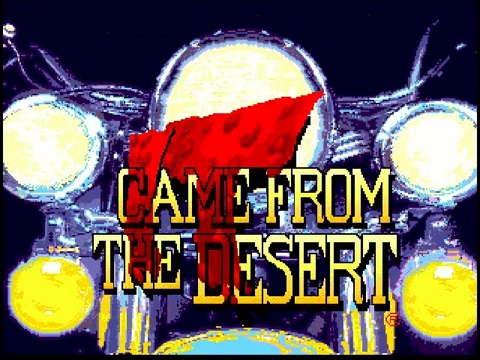
“We decided to take a shot at using real actors filmed against blue screen technology and composited with background photographic plates shot in the real desert. Ken [Melville] and I were in seventh heaven. We were back in the world of actors, voice performances and real music. We had a great time casting the players and I directed for the first time, which was also a gas.”

The TG16 version of It Came From the Desert does have a larger scale like the Amiga version, but the characters and situations are completely different. Gone is Greg Bradley, replaced by Buzz Lincoln, a motorcycle-riding kid who just wants to hang out at the drive-in with his girl, but Dr. Horton T. Pangborne, referred to as “Doc,” needs him to investigate the strange goings on around town. (The town being Lovelock, rather than Lizard Breath, for some reason.) In addition, the ants now have mind powers and are slowly taking over the townspeople.

The performances and writing in the full motion video (FMV) segments aren’t bad, and there are even a few familiar faces among the pixelated sequences – genre vet Musetta Vander (OBLIVION, PROJECT: SHADOWCHASER 3000) plays a fantasy girl on a television that tries to seduce you, and Hugh Dane, the long-suffering security guard Hank on The Office, plays a sax player. Melville even wrote the theme song, “Sea of Love,” performed by Terence Kirby, and it’s genuinely good – not too surprising, as Melville had previously worked on the music for Lucas’s TWICE UPON A TIME and Ernie Fosselius’s PORKLIPS NOW. It’s alluringly self-referential, with dialogue like “This is no mindless bug invasion like those trashy science fiction movies!”

If this version of It Came From the Desert had been a movie, it may have been fairly entertaining, but the interactive aspects were disappointingly limited. The interaction was little more than a few similar mini-games, with a side-scrolling shooter, an overhead-scrolling shooter (not dissimilar to the original Amiga version), and an overhead shooter where you control a sight to aim at ants attacking people on the ground, slowly turning to skeletons. (This part is actually kind of disturbing.) You just don’t do much.
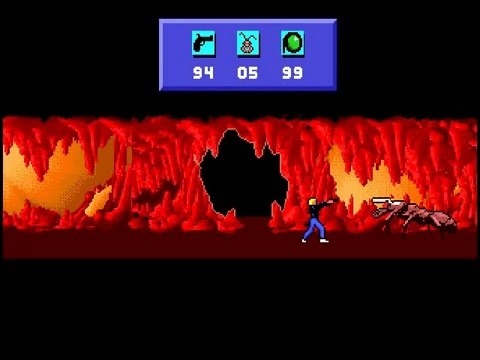
“Unfortunately,” Riordan explained, “we had to use so much of the TurboGrafx’ capabilities for the video sequences, it didn’t leave much for gameplay and Desert III became more of a demonstration piece. What we learned set the stage for our next evolutionary leap in interactive movie making, however. A whole new generation of interactive movies that our team created like Voyeur and Thunder In Paradise were built on what we learned from Desert III.”
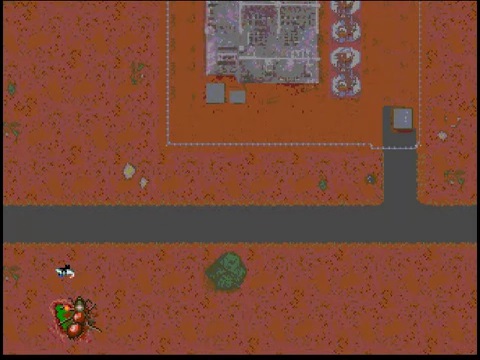
Reviews were critical. “A great idea blended with poor execution. The game play is non existent,” claimed Electronic Gaming Monthly.10 Even the few positives look pretty dire in retrospect, such as TurboPlay’s reaction that the game is “as close to the cutting edge of technology as you’re going to get – full-motion video running at ten frames per second, and very little interruption between scenes.”11 It’s no wonder that TurboGrafx-16 owners have negative recollections of the game.
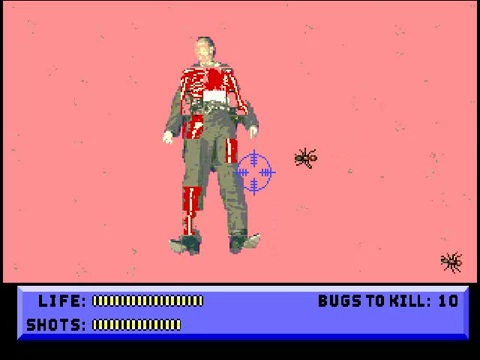
Phase IV – Ant Flow
The TurboGrafx CD release marked the end of the original incarnations to the It Came From the Desert franchise that turned out to be three distinct games crammed awkwardly into one title. David Riordan later went on to produce the well-received FMV game Voyeur as well as television programs for the A&E Network. Ken Melville continued to work in the industry, writing FMV games for the Sega CD including Ground Zero Texas, Sewer Shark and the Make My Video series before his death in 2014. Matt Harmon bounced back from the failure of the Genesis version of Desert to work as lead programmer on The Mask, Project Runway and AND1 Streetball.
The desert itself, however, was quiet – at least until the release of the film that bears its name. While the trailer suggests that it’s based on the TurboGrafx version of the game, one can only hope that it utilizes the wit and winking reference to giant monster movie clichés that are prevalent in the best versions of the title. No release date has yet been announced, so it could come from the desert at any time – even… right… now!
Wait, no, that was just the mailman. It’ll probably come from the desert a little later this year.

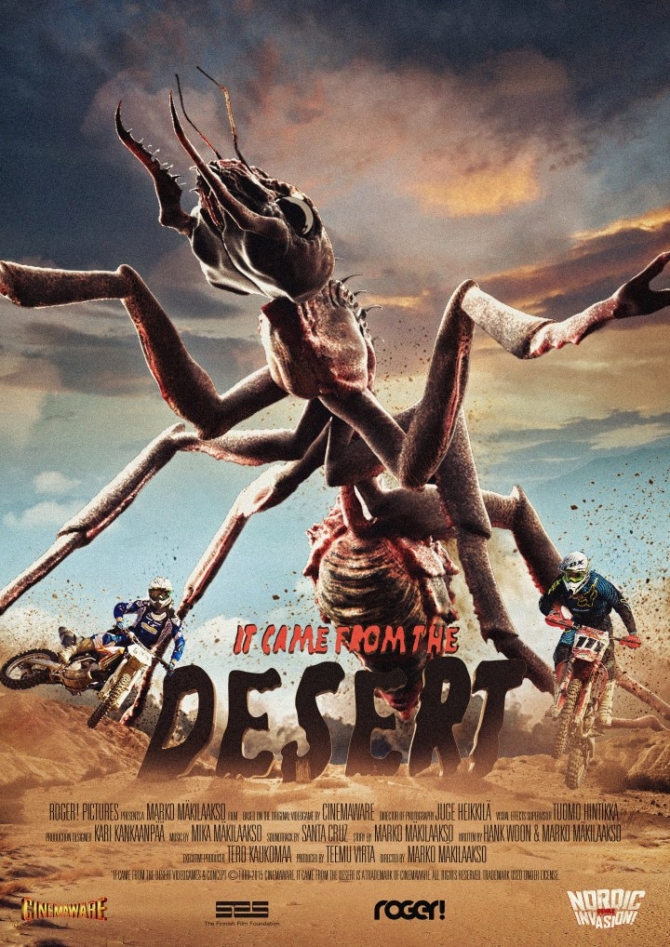
1 – “Cinemaware’s Year in the Desert,” Jimmy Maher, 10/14/16
2 — The Making Of… It Came From the Desert, RetroGamer Issue 30, Spanner, October 2006
3 – Review: It Came From the Desert, Computer Gaming World, Allen L. Greenberg, issue 70, April 1990
4 – Review: It Came From the Desert, CU Amiga-64, Mike Pattenden, January 1990
5 – Review: It Came From the Desert, Amiga Format, Andy Smith, February 1990
6 – Interview: Matt Harmon, Sega-16, Brandon Cobb, 1/27/09
7 – CES show, Mean Machines Issue 17, February 1992
8 – It Came From the Desert ROM, Emuparadise
9 – Cinemaware.com
10 – Review: It Came from the Desert, Electronic Gaming Monthly, April 1992
11 – Review: It Came from the Desert, TurboPlay, Don Nauert, December 1991/January 1992
12 – FMV Game Developer Kenneth Melville Passes Away, Polygon, Alexa Ray Corriea, 2/11/14
13 – Review: Antheads, The One Issue 21, Gary Whita, June 1990
- JIM WYNORSKI RETURNS WITH THE CREATURE FEATURE ‘GILA’ - May 1, 2014
Tags: Ants, Creature Features, Video Games

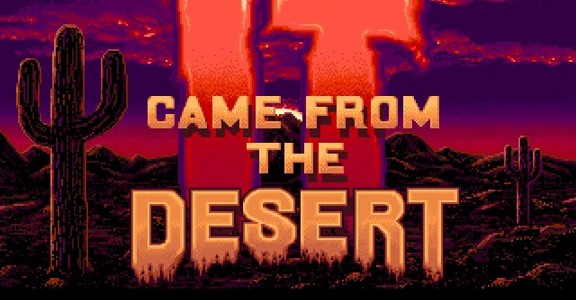

No Comments